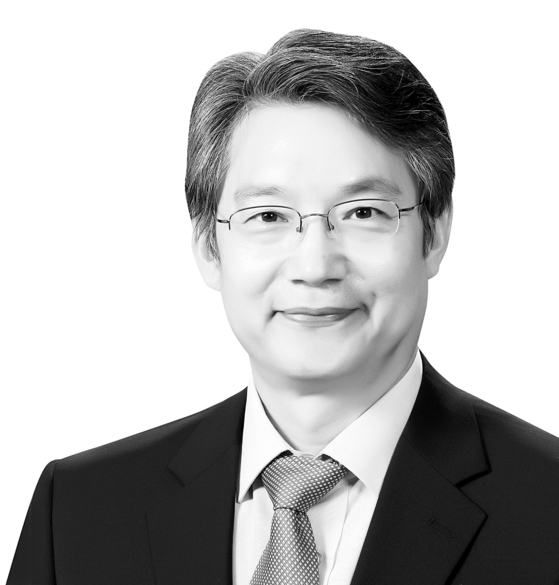A topsy-turvy experiment

The author is a professor of economics at Seoul National University.
North Korea is trying a weird economic experiment — even weirder than the income-led growth policy of the Moon Jae-in administration. The North’s policy is aimed at achieving growth even by sacrificing people’s incomes. Despite a pledge by North Korean leader Kim Jong-un at the 8th Workers’ Party Congress in January to focus on the populace, he only promised to build 50,000 apartments in Pyongyang and 25,000 apartments in Komdok, South Hamgyong Province. Kim underscored the need for his regime to focus on the chemicals and metals industries and increase the production of electricity and coal. His policy prioritizes industrial output over people’s livelihoods.
At the 6th Conference of Cell Secretaries of the party on April 6, Kim made the policy clear by mentioning a reinforced “Arduous March,” demanding his people persevere extreme hardships. But they suffer even more from that very policy. Kim’s order to increase industrial production translates into more burdens for them. If their production targets are raised, state agencies and enterprises mobilize and exploit their labor. That’s not all. The communist party extorts money not only from the rich class, including “donju” — a new breed of people who made money in the recalcitrant state’s half-baked experiment with market economiy — but also from the grassroots. When the regime embarks on massive national projects, it allots assignments to state entities without providing resources needed to carry out the job.
As a result, bribes, extortion, human rights violations, and conflicts of interest take place often. North Korea’s policy is primarily founded on voodoo economics prioritizing industrial output regardless of the people’s livelihoods. The vanity of such quasi-economics was historically proven in the socialist experiments of the Soviet Union and the Eastern Bloc.
The construction of apartments in Pyongyang to improve living conditions only exacerbates the unequal distribution of wealth. According to research, Pyongyang citizens’ per capita income is up to three times higher than other people’s and Pyongyang’s land prices are also about 80 percent higher than other regions’. If massive housing projects are needed, the regime should have considered other relatively poor regions. The move is related to the need for the regime to encourage citizens of Pyongyang — the core base for the regime — to show more loyalty to the North Korean leader.
Another question is whether such apartment construction is really the best idea in times of crisis like this. It would have been better to select the poorest group and offer aid. But that approach does not show much PR effect. A highly visible, large apartment complex is much better for Kim to demonstrate his affection for the people. A head of state’s political calculation is pushing his people a step closer to the edge of the cliff.
Kim Jong-un’s upside-down growth policy originates with Joseph Stalin. According to an estimate, the Soviets’ industrial output increased 50 percent during its first five-year economic plan (1928-32) while their real incomes decreased 50 percent. The Kremlin reasoned that smaller wages would lead to less consumption and that would in turn increase investments. But if companies are pressured to produce more, they only care for the quantity of products, not quality. They can hardly dream of innovation, a determining factor for long-term growth of an economy. The rapid growth in the early days of the Soviet Union was just an illusion created by extreme inefficiency and waste.
Kim’s strategy to copy Stalin is reflected in his speech on the economy. Just as Stalin’s speech was full of numbers on how much industrial production increased without any mention of household incomes, North Korea’s founder Kim Il Sung and his grandson Kim Jong-un are no different. They uphold industrial output at the cost of the people’s livelihoods. The socialism that vowed an end to human alienation and extortion turned out to be a monster treasuring materials more than humanity.
If Kim really wants to enhance his people’s livelihoods, he should try an income-led growth policy, not the opposite. If wages increase in underdeveloped countries like North Korea, workers’ nutrition gets better and that helps raise their labor productivity, not to mention their willingness to work harder. It is irony that North Korea follows in the footsteps of Stalin to pursue a defunct economic experiment whereas South Korea, now an OECD member, presses ahead with an income-led growth policy that should have been tried by the country across the border. A topsy-turvy policy flip is happening on the Korean Peninsula.
Where is the North’s adherence to Stalin’s policies headed? Isn’t North Korea testing the limits of its internal perseverance to help reinforce its negotiating power for denuclearization after having tested the limits of international patience with nuclear weapons in 2017? If North Korea thinks it has reached the limits, it might prepare for a turning point. Does the country know the limits? One thing that’s clear is North Korea is testing the limits with its retrogressive economic experiment.
Translation by the Korea JoongAng Daily staff.










with the Korea JoongAng Daily
To write comments, please log in to one of the accounts.
Standards Board Policy (0/250자)